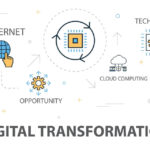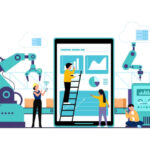Appeared in ExpressComputer.in | 22 July 2021 By Arindam Mitra, Co-Founder and CTO
Good connectivity between different pieces of equipment on the shop floor is important for their communication with each other, which eventually enable smart decision-making. This is one of the aspects of the fourth Industrial revolution, which is all set to re-map manufacturing businesses to deliver higher operational efficiency, better business outcomes and customer satisfaction through digital transformation.
The digital landscape is continuously evolving for the manufacturing industry as businesses are adapting to the change and even anticipating changes before they occur. Fast-changing customer expectations and technological improvements that have brought a paradigm shift in other industries has begun to show the similar results in the manufacturing sector as well.
Smart manufacturing is giving rise to smart factories
Smart manufacturing is more than just automation, as it enables learning and adapting to the ever changing market conditions, delivering higher efficiency in quality control, than that performed by Quality Inspectors. Machines can also take over the task of allocating work to associated machines. Increase in throughput, ensuring 100% inspection, delivering high performance while reducing capital and HR costs are some of the key benefits by leveraging smart technologies. Smart factories enable the making of decentralized decisions which is further made possible with 5G. The fifth-generation mobile network provides capacity and flexibility advantages, besides reducing time-cost for manufacturers.
AI is at the Heart of Industry 4.0
With digital transformation, many manufacturers have begun to leverage AI, ML and Deep Learning technologies to enhance the performance of different processes in manufacturing. Maintenance of equipment for ongoing and reliable production operations is key to any manufacturing plant. Unplanned downtime leads to huge financial losses. AI algorithms and ML deliver near accurate predictions on the condition of the equipment, which is possible with the analysis of the huge volumes of data collected by the machines, thereby making the entire manufacturing process more efficient and productive. With this, maintenance technicians are now able to know the status of the machines and take action in advance with regard to repairs or replacement of defective parts.
The Industrial Internet of Things (IoT) supports the networking of machines on the shop-floor through internet. It enables data collection that drives AI and predictive analytics.
3D Printing Technology to see Increase in Growth
Addictive manufacturing or 3D printing technology enables the creation of 3-dimensional solid object from digital data. Manufacturers can leverage this technology to make prototypes at scale, economically. Those goods that are in high demand are benefiting from this technology. The Additive Manufacturing Trend Report 2021 from 3D Hubs says that 3D Printing Technology market grew by 21% in 2020 despite the pandemic to US$12.6 billion and expected to reach US$37.2 billion in 2026. 65% of engineering businesses leveraged this technology due to the limited accessibility to traditional manufacturing during lockdown.
Up-skilling and Re-skilling the Workforce Adds to the Advantages
It is a common complaint that quality control and other manufacturing related jobs will be replaced by digitization and automation. Yes, those repetitive tasks performed in traditional manufacturing will be phased out as AI-enabled technology will take over, bringing significant reduction in overall costs and increase the productivity. However, human workforce can be up skilled to jobs such as overseeing or managing AI-systems, where they work alongside each other in the new-ecosystem.
Some challenges for organizations to embark on the digital transformation journey continue to exist as both management and employees resist the change and are comfortable with their less effective legacy business models. Such organizations will soon lose to competition in the space. Top management should be convinced with the adoption of new-age technologies and communicate the same to all employees. Furthermore, a robust cybersecurity plan should be put in place without which, cost-optimisation, implementation and even brand image could take a hit. Lack of in-house expertise for Digital Transformation is another area of concern, but can be overcome by partnering external experts and consultants.
The number of benefits and beneficiaries of leveraging Digital Transformation in manufacturing continue to grow despite some challenges. Enhancing business efficiency and productivity, significant cost reduction, delivering actionable insights and enablement of customization are among many others.




